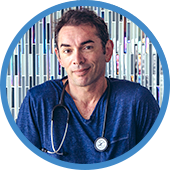Dr. Harry’s Optimal Sports Performance and Recovery Series - Part 2
How Using a Training Program and Post-Workout Nutrition Can Improve Performance Recovery
- Written by Dr. Harrison Weisinger MBBS, PhD.
If you’re like many beginner, non-professional athletes, you may have no idea where to start with training and how to maximize your workouts and post-workout care. Most people don’t know what’s healthy for their body and what isn’t. Particularly when they’re just starting out, and especially in this day and age where there are plenty of companies out there that are just trying to earn a quick buck by forcing expensive supplements and workouts down consumers’ throats.
When patients ask me where to begin, I normally suggest working with a professional by starting out with a training program. This can make an enormous difference both for performance and recovery since there will be an expert guiding your journey. It stands to reason that if you’re going to dedicate hours of time and effort to a sporting pursuit, that you should ask an expert for advice on what to do first.
The good news is that although you might not have the budget for professional advice, there are many popular sporting apps like Training Peaks and Strava which include training programs as part of their annual subscription. And if you look around you’ll generally see a pattern across most, if not all, of these training programs: they comprise of a rotation of hard days, moderate days, and rest days. I urge you to stick to a program which has at least one rest day per week. Why is that important? Read my previous blog to find out.
Fueling for workouts is a science in itself.
I recently read “Endure” by Alex Hutchinson - in which an entire chapter was dedicated to “Fuel”. If you’re not inclined to read a whole book on endurance exercise, allow me to summarise. For low to moderate intensity, we are well equipped to burn fat (as in, the fat stores in our body), provided we have had a period of fat-adaptation. To do so, we need to reduce the amount of carbohydrate being consumed (as in a ketogenic or low-carbohydrate diet). At higher intensities, however, at least a little carbohydrate is helpful - either contained within food, or in a sports drink.
I find that one of the best pre-race (or pre-hard workout) drinks is a combination of MCT oil, a slow-release carbohydrate (see UCAN sports) and a small amount of essential amino acids. MCT oil is a fantastic energy source as it can be used directly by working muscles or converted into ketones by the liver and used as brain fuel when carbohydrate sources are running low.
If you’re interested in trying MCT oil, we have 1L available in our store.
Next, we move on to post-workout nutrition.
This important step to recovery is a complete blind spot to many. The reality, however, is that training can cause severe depletion of both fluid and stored energy reserves. A typical endurance session will deplete athletes of around 2-3% of their fluid volume because very few are disciplined enough or even able to drink enough to prevent it.
Various studies have demonstrated that there is a window of opportunity after a session during which consumed nutrients will replenish those that were used. The window is about 30 minutes. Because this window may close by the time you shower, upload your Garmin file and put your kit in the wash, getting nutrients on board must become your priority.
The most efficient way to replenish fluid and glycogen (stored carbohydrate), and to spare the muscle tissue that would otherwise be cannibalised to make glycogen - is to consume a smoothie or shake containing both proteins and carbohydrates. A standard WPI powder, one banana and water, milk or almond milk will do the trick. Having said that, I used to ride with a former tri champion who swore that two Coronas was all you needed (don’t try this after a weekday morning session)!
Now for a couple of other tips...
This second one is a warning: The human digestive tract is capable of processing only so much food and fluid at a time. So, no matter how long or hard the session was, I recommend for you to consume a small portion every 30-45 minutes after training, rather than stuffing in a massive bowl of pasta and downing 2 litres of Gatorade right away.
Continue Reading Part 3
“How Compression and Massages can Improve Performance Recovery.”
Dr. Harrison Weisinger (MBBS, Ph.D.)
Dr. Harry is the Medical Director for Truth Origins, and a practicing medical doctor in Australia. Throughout his working career as medical doctor, university professor, and scientist, Dr. Harry has committed his life to improving human health. Each month he reads the various journals and studies being conducted across the world’s leading universities and research hospitals to bring you the latest research surrounding the truth about plant-based medicine.
Read our most recent blogs:
LIKE THESE ARTICLES?
STAY UP-TO-DATE
Join the Truth Origins club to stay up-to-date on our latest articles, blog posts, updates and exclusive discounts. You'll also receive 10% OFF your first purchase for joining.










